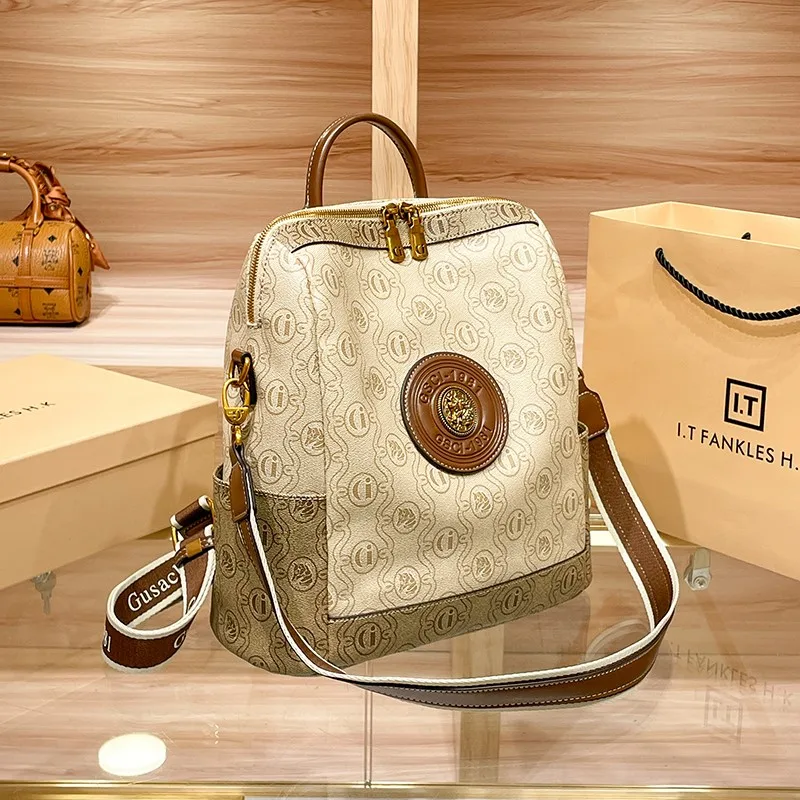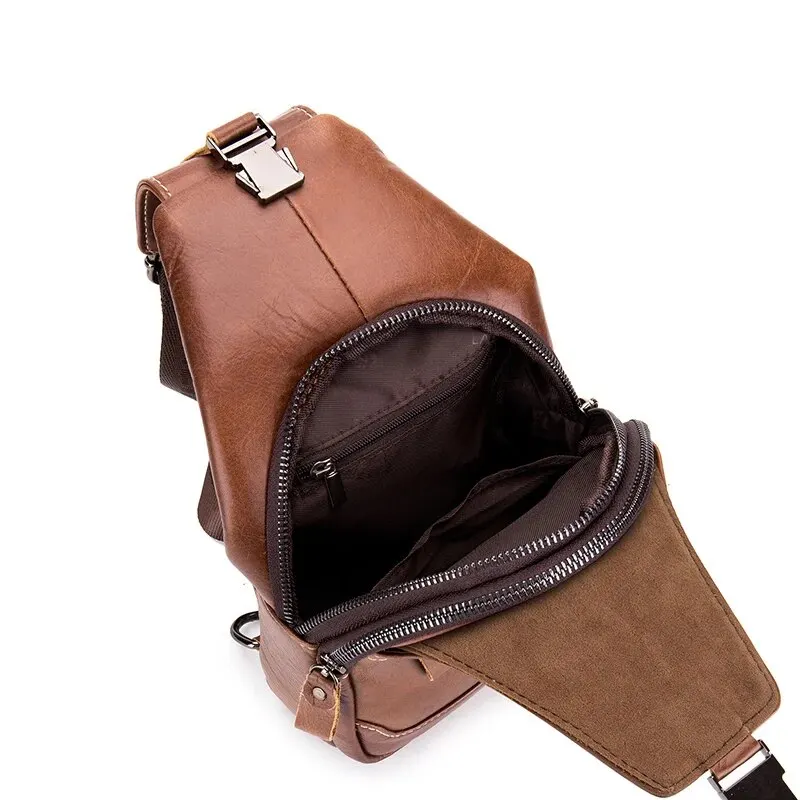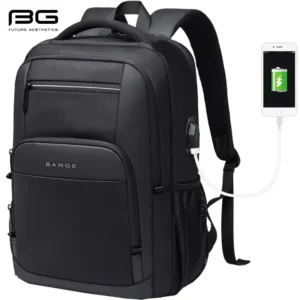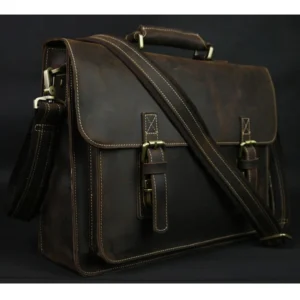Introduction: The Refined Art of Organizing Your Small Leather Backpack
Small leather backpacks represent the perfect marriage of elegance and functionality. These premium accessories offer a sophisticated way to carry your essentials while making a style statement. Yet many of us struggle with the same challenge: how do we maximize the limited space in these compact bags without compromising their beautiful shape and appearance?
The difference between a frustrating morning scramble and a smooth day often comes down to one thing—organization. A thoughtfully organized leather backpack transforms from a chaotic black hole where items disappear into an efficient carrying system where everything has its place.
At Summit Carry, we believe that organization isn’t just about tidiness—it’s about enhancing your daily experience with our premium leather goods. Our designs incorporate intentional organizational elements because we understand how proper arrangement protects both your belongings and your investment in quality leather.
How many times have you found yourself frantically digging for keys or your phone while balancing coffee in one hand? With the comprehensive organization system we’ll explore in this guide, you’ll discover how to:
- Maximize every inch of space in your compact leather backpacks
- Create intuitive access to frequently used items
- Protect both your belongings and the leather itself
- Maintain the elegant silhouette of your small leather backpack
Why Expert Organization is Essential for Premium Leather Backpacks
When it comes to small leather backpacks, organization isn’t just a matter of convenience—it’s essential for preserving both functionality and aesthetics. Here’s why thoughtful organization matters especially for premium leather backpacks:
Space Optimization: Every cubic inch counts in a compact design. Unlike larger bags where items can simply be tossed in, small leather backpacks require strategic placement to maximize capacity. Proper organization can effectively double your usable space.
Enhanced Accessibility: Nothing’s more frustrating than having to empty your entire backpack to find one small item. Smart organization creates intuitive pathways to your belongings, saving time and reducing daily stress.
Item Protection: Disorganized bags lead to items scratching against each other and the interior lining. Keys can scratch your sunglasses, and pens may leak onto the leather interior—proper compartmentalization prevents these damaging interactions.
Aesthetic Preservation: One of the hallmarks of a quality leather backpack is its elegant silhouette. Poor packing creates unsightly bulges and distorts the leather’s natural shape. Thoughtful distribution of weight maintains the bag’s intended profile.
Leather Longevity: Premium leather requires thoughtful treatment. Overloading certain areas creates stress points that can permanently stretch or deform the material over time. Even the finest full-grain leather from the ultimate guide to small leather backpacks will show premature wear when consistently subjected to improper packing.
When leather is forced to accommodate poorly organized contents, the material stretches unevenly. Pointy objects may create pressure from the inside, while abrasive items can damage interior linings. The investment you’ve made in a premium leather backpack deserves protection through mindful organization.
As we move forward, we’ll examine how to prepare your mini leather backpack for optimal organization—because proper arrangement begins with proper assessment.
Before You Begin: The Essential Preparation Steps
Before implementing any organization system, proper preparation creates the foundation for success. Follow these four crucial steps to set the stage for an effectively organized leather backpack:
1. Complete Emptying
Start with a clean slate. Remove everything—including items from those small, often-forgotten pockets. This complete reset allows you to:
– Evaluate what you’ve been carrying unnecessarily
– Discover lost items
– Access all parts of the backpack for cleaning
2. Strategic Evaluation
This critical step involves honestly assessing what truly belongs in your daily carry. Ask yourself:
– Have I used this item in the past week?
– Does this item serve multiple purposes or just one?
– Is this the most compact version of this item I could carry?
– What would happen if I didn’t have this with me?
This evaluation typically reveals several items you’ve been carrying out of habit rather than necessity.
3. Interior Cleaning
Maintaining the cleanliness of your backpack’s interior is essential for both organization and leather preservation. Even the smallest debris can accumulate and damage your bag’s interior. For proper leather backpack cleaning:
– Use a lint roller to remove dust and small particles
– Gently vacuum interior corners with a small attachment
– Follow manufacturer recommendations for treating the specific interior material
– Allow the interior to fully dry before reorganizing
4. Structure Assessment
Every designer mini backpack has unique organizational features. Take time to:
– Identify all compartments, pockets, and specialized storage areas
– Note the dimensions of each space
– Understand which areas provide the most protection
– Recognize which pockets offer easiest access when the backpack is worn
Understanding your backpack’s specific architecture allows you to make strategic decisions about item placement rather than random stuffing.
With these preparation steps complete, you’re ready to implement a systematic organization approach that maximizes functionality while protecting your premium leather investment.
Core Organization Principle: Categorize and Contain
The foundation of effective small leather backpack organization rests on a simple yet powerful principle: categorize and contain. This approach transforms chaos into order while preserving your backpack’s elegant silhouette.
Why Categorization Works
Grouping similar items creates logical organization that your brain can easily remember. Instead of searching for individual items, you’ll reach for categories:
– Daily essentials (wallet, keys, phone)
– Technology (cables, earbuds, power bank)
– Personal care (hand sanitizer, lip balm, medications)
– Work/productivity tools (pens, notebooks, business cards)
The Container Advantage
Within a leather backpack, soft, slim pouches are vastly superior to rigid containers. They:
– Conform to the leather’s natural flexibility
– Prevent scratching of the interior
– Allow for better space utilization
– Can be arranged vertically or horizontally as needed
When selecting containment tools for organizing leather backpack guide implementation, prioritize:
- Lightweight materials: Every ounce adds up in a small backpack
- Slim profiles: Avoid bulky organizational tools that consume space
- Non-abrasive fabrics: Microfiber, soft canvas, and thin leather work well
- Visual distinction: Different colors or patterns help identify contents quickly
Recommended Containment Systems:
For tech items: Slim zippered pouches with minimal padding protect without bulk
For small essentials: Clear, flat pouches allow visual identification without opening
For cables/cords: Elastic organizers or small fabric pouches prevent tangles
For writing tools: Narrow pencil cases or dedicated pen slots
By establishing these category-based containment systems, you create a foundation that makes compartment utilization intuitive and efficient.

Strategic Compartment Utilization in Small Leather Backpacks
Understanding how to leverage each compartment of your leather backpack creates an organizational symphony where everything has its place. Let’s break down the strategic approach by compartment type:
Main Compartment
The largest space requires the most thoughtful arrangement. Implement these principles:
- Layer flat items against the back: Notebooks, tablets, or folders should rest against the back panel where they won’t bend or distort
- Arrange pouches vertically: Standing pouches side-by-side like books on a shelf creates visual organization and maximizes space
- Place heavier items at the bottom center: This distribution prevents the backpack from feeling lopsided or straining one side of the leather
- Use the full height: Many people only fill the bottom half of their backpack, wasting valuable space
When packing light in a small backpack, remember that vertical space is often underutilized.
External Quick-Access Pockets
These smaller compartments should house your most frequently accessed items:
- Front pocket: Perfect for transit cards, hand sanitizer, and lip balm
- Side pockets: Ideal for water bottles, umbrellas, or phone (items you need while walking)
- Hidden back pocket: Secure yet accessible spot for valuable flat items like passport or extra cash
The rule: if you’ll need it while wearing the backpack, it belongs in an external pocket.
Internal Pockets & Slots
Many women’s leather backpacks include thoughtfully designed internal organization:
- Pen slots: Use for writing tools exclusively (not makeup brushes or other items that may leak)
- Phone pocket: Perfect for your phone or similarly sized device that needs protection
- Zippered security pocket: Ideal for valuable small items like jewelry or medication
- Card slots: Use for business cards, credit cards, or ID cards you don’t access constantly
Avoid the temptation to stuff these specialized spaces with random items—respect their intended purpose.
Hidden Security Pockets
These discrete storage areas serve a vital security function:
- Reserve for truly valuable items only (not everyday items)
- Don’t overfill, as bulging security pockets defeat their purpose
- Consider using for emergency items (backup payment method, important contact information)
By respecting each compartment’s purpose and optimizing its use, you transform your small leather backpack into an organizational masterpiece where everything has a logical home.
The Perfect Placement: Where to Store Common Items
Creating an intuitive system for common items transforms your daily experience with your versatile compact leather bag. Here’s your comprehensive guide to optimal placement:
Essential Access Items
These are items you need frequently and quickly:
- Keys: Attach to a key clip in the top internal pocket or front external pocket; always secure to prevent scratching leather or other contents
- Phone: Place in a dedicated phone slot or the most accessible external pocket
- Wallet/Cards: Store in an internal zippered security pocket, or use a slim card case in a quick-access pocket
- Transit Cards: Keep in the most external pocket for tap-and-go access
Technology
Electronic items require special consideration:
- Cables: Roll (never fold) and secure with small elastics or dedicated cable organizers in an internal pouch
- Earbuds: Store in a small protective case in a quick-access pocket
- Power Bank: Position vertically in the main compartment, ideally in a slim pouch
- Adapters: Place in the same tech pouch as cables for logical grouping
Many leather laptop backpacks include padded sleeves specifically for electronics.
Professional Items
Work essentials deserve dedicated space:
- Business Cards: Use internal card slots or a slim card case
- Pens/Pencils: Always cap securely and place in dedicated pen slots or a slim pen case
- Notebooks: Store flat against the back panel of the main compartment
- Small Planner: Position vertically alongside notebooks in the main compartment
Personal Care
Keep these items contained to prevent leaks:
- Lip Balm/Lipstick: Store in a small internal pocket or dedicated cosmetics pouch
- Hand Sanitizer: Ensure the cap is secure and place in an external pocket for easy access
- Medications: Keep in a dedicated small pill case in an internal zippered pocket
- Tissues/Wipes: Store travel packs in an external pocket for quick access
Everyday Tools
Practical items you may need throughout the day:
- Compact Umbrella: Secure in a side pocket or vertically in the main compartment
- Sunglasses: Always use a protective case and store in the main compartment
- Reusable Shopping Bag: Fold compactly and tuck into an internal pocket
By assigning each item a logical home based on access needs and protection requirements, you create an organizational system that becomes second nature. You’ll no longer waste time searching—your hand will instinctively know where to find each item.
Essential Organization Accessories for Small Leather Backpacks
The right accessories amplify your organization system without adding unnecessary bulk. These tools work harmoniously with small leather backpacks to maximize space and functionality:
Slim Pouches
These versatile containers are the cornerstone of good organization:
- Fabric pouches: Opt for lightweight microfiber or canvas options no more than 1/2 inch thick when filled
- Leather pouches: Choose thin, flexible leather that complements your backpack’s aesthetic
- Clear pouches: Ideal for small items that tend to get lost (hair ties, bandages, coins)
Size recommendation: Select pouches no larger than 7” x 5” to fit perfectly within small backpack compartments.
Cable Management
Tame technology tangles with these specialized tools:
- Silicone cable ties: Reusable, flexible, and gentle on cords
- Roll-up cable organizers: Compact fabric solutions with dedicated elastic loops
- Magnetic cable clips: Tiny but effective for preventing cables from sliding to the bottom of your bag
Key Management
Protect your bag’s interior while keeping keys accessible:
- Leather key clips: Attach to internal D-rings or loops within your backpack
- Retractable key chains: Allow you to use keys without detaching them from your bag
- Key organizers: Compact tools that fold keys together to prevent jangling and scratching
Card Storage
Streamline bulky wallets with these alternatives:
- Slim card cases: Hold 4-6 essential cards without excess bulk
- Accordion card holders: Organize multiple cards in minimal space
- RFID-blocking sleeves: Protect digital information in a paper-thin package
Protection Accessories
Safeguard fragile items with these specialized tools:
- Soft sunglasses cases: Much slimmer than rigid cases while still offering protection
- Padded technology sleeves: Custom-sized to prevent excess bulk
The best accessories for convertible leather backpacks complement rather than compete with the bag’s existing features. Look for items that are:
– Slim and lightweight
– Flexible rather than rigid
– Complementary in color or material to your backpack’s aesthetic
– Multipurpose when possible
These thoughtfully chosen accessories become the invisible infrastructure that supports your organization system, allowing you to maximize every inch of your small leather backpack.
Daily Habits for Maintaining an Organized Leather Backpack
Establishing consistent routines transforms organization from a one-time effort into an effortless daily practice. These simple habits will keep your leather backpack perfectly organized with minimal effort:
1. The One-Minute End-of-Day Reset
Take 60 seconds each evening to:
– Remove trash, receipts, and items that don’t belong
– Return shifted items to their designated places
– Check for any caps that have come loose
– Place your most essential morning items in quick-access locations
This brief evening ritual prevents organizational decay and makes mornings smoother.
2. The “One In, One Out” Rule
Small leather backpacks demand discipline. When adding a new regular item:
– Identify something of similar size to remove
– Question whether the new item is truly necessary
– Consider if a smaller version could serve the same purpose
This practice prevents gradual overfilling that strains leather and zippers.
3. Strategic Receipt Management
Receipts quickly create chaos. Implement this simple system:
– Designate one specific pocket exclusively for receipts
– Empty this pocket every evening
– For important receipts, take a photo and then discard the paper
4. Weekly Quick-Clean Process
Spend five minutes each weekend on this maintenance routine:
– Remove all items from your backpack
– Wipe down interior surfaces with a clean microfiber cloth
– Check organization pouches for cleanliness
– Assess if your current organization system is working optimally
Regular leather backpack maintenance preserves both organization and material quality.
5. Adaptability for Different Daily Needs
Create simple swappable modules for different scenarios:
– Work essentials pouch
– Gym necessities pouch
– Weekend exploration kit
This modular approach allows your luxury leather backpack to adapt to changing needs without complete reorganization.
By incorporating these simple habits into your routine, you transform organization from a periodic chore into an effortless daily practice. The small investment of time yields tremendous returns in accessibility, efficiency, and backpack longevity.
Troubleshooting Common Organization Challenges
Even with the best intentions, organization challenges arise. Here are practical solutions to the most common issues:
Bulging and Shape Distortion
Problem: Your backpack loses its elegant silhouette and looks overstuffed.
Solution:
– Distribute weight evenly across the bottom rather than concentrating in one area
– Store flat items against the back panel to maintain structure
– Avoid overpacking—be ruthless about what truly needs to be carried
– Use soft pouches that conform to available space rather than rigid containers
Difficulty Finding Small Items
Problem: Small essentials like lip balm, earbuds, or keys seem to vanish in your bag.
Solution:
– Implement a color-coding system for small pouches
– Place frequently lost items in bright-colored containers for visibility
– Use clear pouches for the smallest items
– Assign dedicated homes for small essentials—never let them float freely
Cable Tangling
Problem: Charging cables become a knotted mess at the bottom of your bag.
Solution:
– Never place loose cables in your bag—always secure them
– Wind cables in a figure-8 pattern around two fingers before storing
– Use small silicone cable ties or velcro wraps
– Store different types of cables in separate compartments
Bottom-of-Bag Chaos
Problem: Small items migrate to the bottom of your backpack, creating a jumbled mess.
Solution:
– Implement vertical storage using slim pouches that stand upright
– Use the full height of your backpack rather than just the bottom
– Place smaller items in zippered pockets rather than the main compartment
– Group similar small items together in dedicated containers
Leather Stress Points
Problem: Certain areas of your vintage leather backpack show premature wear or stretching.
Solution:
– Avoid overloading any single compartment
– Distribute weight evenly across the bottom of the bag
– Place hard or sharp-edged items in protective sleeves
– Rotate which compartments you use most frequently
By addressing these common challenges proactively, you’ll maintain both the function and beauty of your small leather backpack for years to come.

Advanced Organization for Different Scenarios
Your small leather backpack can adapt to various situations with thoughtful reorganization. Here are specialized setups for common scenarios:
Work-to-Gym Transition
Transform your professional companion into a fitness essential:
- Keep work items (notebook, tech) in the main compartment
- Use a water-resistant pouch for gym clothes in the bottom section
- Store shower essentials in a dedicated waterproof pouch
- Position workout shoes in a separate antimicrobial bag
- Tip: Remove unnecessary work items before adding gym gear
Minimal Essentials for Evening Outings
When styling your leather backpack for casual outfits, pare down to the necessities:
- Transfer only essential cards to a slim cardholder (leave the full wallet)
- Bring only the keys you’ll need on a detachable key fob
- Select versatile cosmetics that serve multiple purposes
- Position phone in the most accessible pocket
- Consider a small fold-flat reusable shopping bag for unexpected purchases
Weekend Exploration Setup
Optimize for a day of discovery:
- Position a small water bottle on one side
- Store snacks in a resealable pouch in an easy-access compartment
- Keep a compact portable charger in an internal pocket
- Arrange map/guide materials flat against the back panel
- Leave extra room for souvenirs or discoveries
Travel-Day Organization
Maximize accessibility when on the move:
- Place travel documents in a dedicated folder in the most secure compartment
- Position comfort items (eye mask, ear plugs) in a quick-access pocket
- Store charging cables and adapters together in a tech pouch
- Keep medications in a small labeled container in an internal zippered pocket
14 Inch Leather Laptop Backpack, Brown Leather Backpack, Men's Leather Backpack, Vintage Leather Backpack
Price range: $177.28 through $199.12 Select options This product has multiple variants. The options may be chosen on the product pageDesigner Men's Backpack, Men's Leather Laptop Backpack, Men's Leather Work Backpack
Price range: $158.04 through $160.04 Select options This product has multiple variants. The options may be chosen on the product pageDesigner Mini Backpack, Mini Leather Backpack, Small Leather Sling Backpack, Women's Leather Backpack
Price range: $95.76 through $98.80 Select options This product has multiple variants. The options may be chosen on the product pageDesigner Mini Backpack, Designer Women's Backpack, Mini Leather Backpack, Women's Leather Backpack
Price range: $135.92 through $137.64 Select options This product has multiple variants. The options may be chosen on the product page15 Inch Leather Laptop Backpack, Leather Briefcase Backpack
$332.96 Select options This product has multiple variants. The options may be chosen on the product page17 Inch Leather Laptop Backpack, Men's Leather Travel Backpack, Men's Leather Work Backpack
Price range: $106.28 through $143.88 Select options This product has multiple variants. The options may be chosen on the product page
The versatility of designer women’s backpacks allows for these quick transformations while maintaining organization integrity. The key is developing a modular approach where certain items remain constant while others are swapped based on the day’s needs.
How Proper Organization Extends Your Leather Backpack’s Lifespan
Organization isn’t just about convenience—it’s a form of leather care that significantly extends your backpack’s life. Understanding this connection helps protect your investment:
Prevention of Stress Points and Stretching
Disorganized packing creates uneven pressure that stretches leather in ways it wasn’t designed to accommodate. Proper weight distribution prevents:
– Corner bulging that permanently deforms the backpack’s shape
– Zipper strain that leads to premature failure
– Seam stress that can cause splitting over time
Reduction of Interior Abrasion and Wear
Uncontained items moving freely inside your backpack cause constant friction against the interior lining. Organization systems prevent:
– Premature lining wear in high-friction areas
– Pilling or tearing of interior fabrics
– Color transfer from items to the lining
Minimizing Exposure to Potentially Damaging Items
Properly contained items are less likely to damage your leather. Thoughtful organization prevents:
– Key scratches on interior or exterior leather
– Pen marks or ink leaks on linings
– Makeup or lotion spills that can stain leather permanently
Supporting Proper Leather Aging and Patina Development
Quality leather develops character over time, but this process should be even and natural. Good organization promotes:
– Even wear patterns across the backpack
– Uniform patina development free from premature wear spots
– Natural aging that enhances rather than deteriorates appearance
A well-organized backpack typically outlasts its disorganized counterpart by years, making ultimate leather conditioning and organization complementary aspects of proper leather care.
The difference becomes particularly evident around the 2-3 year mark, when disorganized bags often show premature wear while well-organized ones continue to look refined and develop beautiful character.
Your Daily Carry Essentials Checklist
Use this practical reference tool to evaluate what truly deserves space in your women’s leather sling backpack or traditional backpack. This checklist helps maintain organizational discipline:
Everyday Essentials
- Phone
- Keys (only those needed daily)
- Payment method (slim wallet or card case)
- Lip balm
- Hand sanitizer (small size)
- Sunglasses in slim case
- Portable charger (only if needed daily)
Situational Additions
- Notebook/planner (if used that day)
- Makeup essentials (only what’s needed for touch-ups)
- Medication (daily doses only)
- Water bottle (consider collapsible options)
- Snack (in sealed container)
- Earbuds (if used regularly)
Evaluation Questions for Each Item:
- Will I definitely use this item today?
- Is this the smallest/lightest version that meets my needs?
- Could I borrow this if needed rather than carrying it?
- What would happen if I didn’t have this with me?
- Does this item serve multiple purposes?
Rotation System Guidelines:
- Regularly assess which items you actually use
- Remove seasonal items when not needed
- Consider a “maybe” area in your home for items you’re unsure about
- Keep a small “essentials kit” that moves between bags
This checklist isn’t about deprivation but about intentional choices that enhance your daily experience. The goal is carrying what truly adds value while leaving behind what merely adds weight.
Embracing the Art of Less: Mindful Carry Philosophy
Organization is ultimately about more than efficiency—it’s about creating space for what matters. The philosophy behind mindful organization connects to deeper principles:
Quality over quantity becomes a natural guiding principle when space is limited. Our black leather backpacks aren’t designed to carry everything possible, but rather to carry the right things beautifully. This constraint encourages discernment about what deserves to occupy your personal space.
The relationship between organized carry and reduced stress is profound. When you know exactly where everything is, a layer of low-grade anxiety disappears from your day. No more frantic searching or wondering if you’ve forgotten something essential.
Premium leather goods naturally encourage more thoughtful choices. The refined aesthetic and careful craftsmanship of quality leather inspire a similar level of intention in how we use these pieces. There’s a satisfying alignment when the care taken in creating a product is matched by the care taken in using it.
The benefits of compact bags in modern life extend beyond practicality to psychology. In a world of constant excess, there’s something refreshing about the discipline of carrying only what serves a purpose. This intentional limitation often feels like freedom rather than restriction.
Finding satisfaction in a perfectly organized system creates small moments of joy throughout your day—reaching for your keys and finding them exactly where they belong, or opening your bag to find everything in its place. These tiny victories contribute to a sense of control and competence that extends beyond your backpack.
Your small leather backpack isn’t just a vessel for carrying possessions—it’s a daily practice in mindfulness, quality, and intentional living. When organized with care, it becomes both a practical tool and a quiet reminder of the beauty found in thoughtful simplicity.






